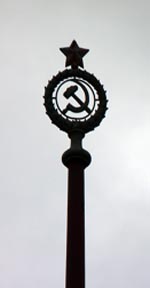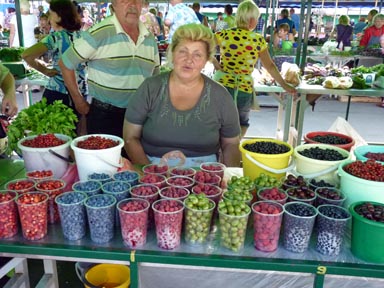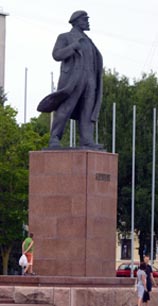Last years trip from China to North Korea to Russia ended at Vladivostok. When my fave tour company announced that they would repeat the route this year and continue north, I said “sign me up!” Although the other participants were meeting in Vladivostok, I will join them in Magadan. Frequent frequent flier miles get me as far as Moscow, from which I can fly direct.
The flight over is quite tolerable, but only because I'm in business class. (Another frequent flyer award.) It leaves New York in the evening and is supposed to arrive mid-morning; my onward flight is not until evening. The issue of what to do during the day in Moscow is largely resolved by Delta: we arrive three hours late. Another three hours is consumed by the train from Sheremetovyo airport into the city, a subway tour across Moscow, then another train to Domodedovo airport. The temperature is a summery but, due to the lack of air-conditioning, a not very pleasant 82°.
More delays. By the time we board the Transaero 767 it's almost 10PM but still light outside. It never gets dark as we cross 8 time zones and land at Magadan at 4 PM local time. Following the almost inexorable rule of Soviet planning, the airport is an hour from the city it serves. A local rep is on hand to greet me and drive me to the hotel. On the way in, she explains that Magadan is in the Russian Far East, NOT in Siberia – that term is reserved for the interior. Whatever you call it, in July the hills surrounding the airport are still capped in snow.
The others arrive two hours later on a flight from Vladivostok, 1400 miles to the south (air or sea are the only route choices; there is no road). The tour is a sellout: we are 18, including several veterans from last years crew.
No one (sane) goes to Magadan voluntarily. The name evokes the worst of the gulag system. It was the epicenter of a network of labor camps to which vast numbers were exiled and from which few returned. Geologists discovered mineral riches in the region in 1929, and Stalin had a ready and endless source of slave labor to exploit them. From 1932-1956 hundreds of thousands were sent by train to Vladivostok, then north by ship to Magadan, then dispatched to the Kolyma gold fields, mines, and other labor camps where harsh treatment competed with winter temperatures that reach 60 below. Insects made the summers equally hellish.
We check into the best hotel in town. The rooms are fairly modern, but the service harks to days past. I am in a two-room suite with two bathrooms, except one is out of order. A request to change rooms is met by bureaucracy, buck-passing, bad attitude and empty promises of forthcoming repairs. Finally, by 10 PM, a solution is reached: the others are told that they can't use “my” bathroom but instead must use the upstairs gym. I half-expect that, instead of a plumber, workmen will show up and install a sign saying “private: Ron’s bathroom.”
My two-word description of Magadan is ”enervated post-Soviet.” Things have run down more than they have changed. The main drag is still Lenin Street and one over is Dzerzhinsky (founder of the Cheka, forerunner to the KGB). Not much new has been built in the last twenty years, a notable exception being a very impressive Russian Orthodox cathedral under very slow construction. (The Lenin statue was moved a few blocks to make way.) Extractive industries and fishing are hardly enough to support its population of 300,000, but it’s not so easy to leave. The cost of living is extraordinaraly expensive (think Alaska), but wages are not commensurate. Many exist in an economic twilight, with alcohol as the only diversion.
I left New York on Thursday, passed through Moscow on Friday, and arrived on Saturday. Sunday we spend sightseeing. The first stop is an overlook of the harbor. Like all public gathering spots we visit today, heaps of empty bottles and other detritus mark a night of public drinking. Below, during Magadan’s heyday Stalin’s fleet of slave ships unloaded prisoners by the thousands. More than one slave ship that left Vladivostok late in the season became stranded in the ice, and by Spring all the prisoners had frozen to death. There is no road from the south, so everything comes in by ship. Modern icebreakers allow the harbor to be used all year.
Next, a visit to the Mask of Sorrow, Russia's principal monument to the horrors of the gulag. It’s on a hill overlooking the city; unlike most modern mega-sculptures, it is pretty good, with many symbolic themes and a multi-faceted visage. Although Magadan is a completely appropriate location, its position at the remote edge of the former USSR ensures that few outsiders will ever see it.


Lunch is at the CCCP Cafe. It has a retro-nostaglia decor, but I wonder who is the intended market: no one here thinks communism is camp, and there is a dearth of tourists who might.
We than stop in on a local carver. Up to now I have never seen a carved walrus penis bone, so I didn't know I needed one. But what I decide I really need is a mammoth tusk; there is a huge trove preserved in the permafrost across Siberia, and specimens are uncovered from time to time. You can buy carved segments or even an entire tusk.


The regional museum has two main themes. The first is the history of and artifacts from the gulag. The lack of English captioning makes for a rapid scan of what are probably interesting exhibits. The second focus is natural history and resources. Besides mammoth tusks, the ground here yields exotic minerals, which, oddly enough, come in the shape of chess sets.


One of my concerns was that my few days here would be ruined by rain, which is frequent in the summer (much like southern alaska), but we are in luck with a rare sunny spell. We head to the beach. At 5:30 PM the sun is high in the sky and people are still arriving. The water is way too cold for this Floridian, but the scenery is excellent.
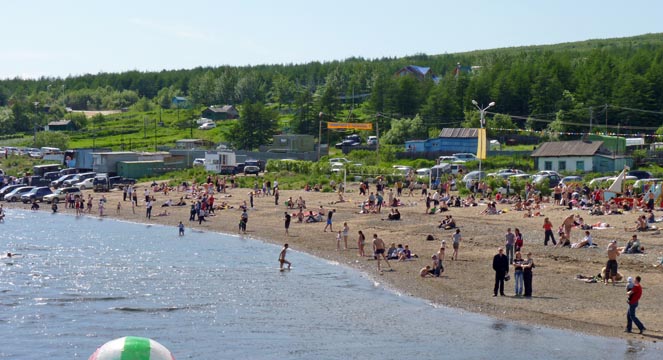

Although Magadan is south of the Arctic Circle – it's the same latitude as St. Petersburg – around the summer solstice it never really gets dark. Twilight descends around midnight, but by 3AM it is fully bright again.
The next day our adventure begins: two huge Ural trucks have been obtained from the Ministry of Culture to transport us to Dneprovsky Gulag where we will camp the night. We have drivers, local guides, and armed guards – this is bear country. On the way a safety lesson: the Russian word for “bear” is “medved,” the same as the current president; if you see one and shout “Putin,” don’t expect help to arrive.
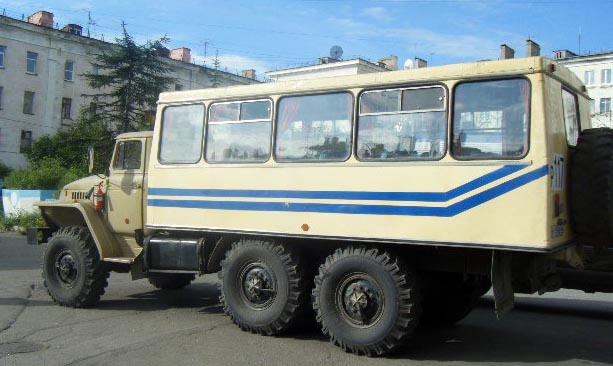
Most of the way we travel the Kolyma Highway, which runs 1200 miles from Yakutsk to Magadan. It's also known as the “Road of Bones” because it's figuratively paved with the bones of the prisoners who died building it. (Actually, the road is unpaved.) We don't make much speed –the journey takes eight hours – but the rugged vehicles are essential for the last hour after leaving the highway. There was once a road to the camp, but it's long gone. We ford several streams as we blaze a trail through the brush. On the way we spot a bear, a magnificent golden bruin at full gallop.


Of the hundreds of camps that comprised the Gulag Archipelago, most have completely disappeared. Owing to its remoteness, Dneprovsky is one of the best-preserved. From 1941 to 1955 some 1500 prisoners worked at the camp digging and smelting tin. The hills are dotted with abandoned mine shafts and collapsing buildings. In many respects it resembles ghost towns out west.

We make camp right where the prisoner barracks used to be. While we take a walking tour, the men set up the tents. There is firewood aplenty: the boards that comprised the gulag structures. No one seems concerned that we are consuming what we came to see, probably because this place gets so few visitors. We are the largest group of foreigners ever to visit. (Though Vice-President Henry Wallace came to Magadan in 1944 and was fulsome in his praise.)

We hike among the still-standing watchtowers. Although the guards stood ready to shoot, there was nowhere to escape to; the harsh wilderness itself was a death sentence. Scattered among the barbed wire are lamps and implements fashioned from US lend-lease food tins.
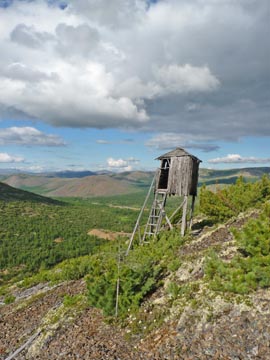
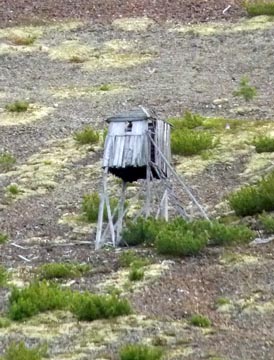
Before setting out we are issued whistles and flares and get a briefing: if you see a bear in the distance, take photos. If he comes closer, blow your whistle. If you hear a whistle, go towards it, because bears are unlikely to attack a group. If one gets really close, then you still have your flare; no bear will charge into a three-foot red flame. By that time, someone with a rifle will have arrived – at least that’s the plan.
All for naught: we don't run into any bears. But boy are there mosquitoes! Clouds of them everywhere! The repellent we have is quite effective, but while the camp was in operation there was no such relief for either prisoners or guards. Dozens of skeeters converge on any small patch of unsprayed skin. They are so ravenous that they don't even try to fly away when you swat them. A man tied naked outside – one of the means of torture employed in the day -- would be dead within twenty-four hours.
A roaring fire plus plenty of DEET plus copious amounts of vodka plus ample bonhomie makes for an animated evening. I turn in early, a bit past 1 AM, even though it is hardly dark. Flashlights were an unnecessary item on the packing list.
In the morning we visit the camp cemetery. The roughly 100 graves are marked with only with prisoners’ number tags; the corpses of those who died while the ground was frozen had to be disposed of by other means. We then visit the remains of the smelter, a three story wooden structure that burned to the ground some years ago. When we return to the camp, the men have packed up and we are ready for the road back.


Another night in Magadan, then the second part of the trip: Abandoned Russia. Under communism, factories and cities were sited for various reasons, but economic viability was far down on the list. The transition from central planning to market economics has been driving a large scale depopulation of an already sparsely-settled region. On the road to the gulag camp we passed several abandoned factory towns. Today we are headed for the biggest of them all, Kadykchan, ghost city of Siberia.
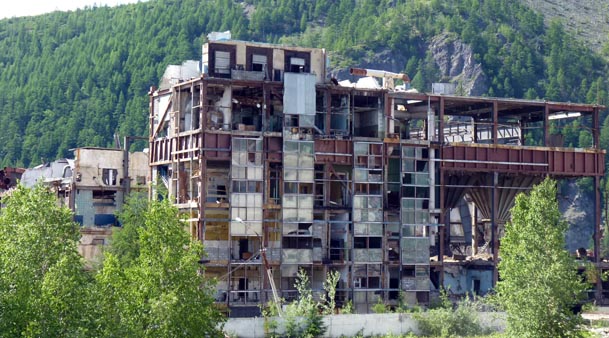
It lies 400+ miles up the Kolyma Highway, about a third of the way to Yakuskt. In contrast to Pripyat, the abandoned radioactive town near Chernobyl which has become something of a tourist destination (I went), nobody goes Kadykchan – we think we are the first tour group ever to visit.
Traveling as far as road conditions permit, it takes us over twelve hours to reach Susuman, where we will spend the night. Although there is no actual hotel, a mining company maintains rooms for transient workers; they prove surprisingly comfortable. The town has contracted in size, but is still inhabited: the main street features three cell-phone outlets, a video store, and a couple of small food shops. There is a small cafe where we eat all our meals, each one a variation of pork. Theoretically we could have flown here, except the airport shut down years ago.

Our destination lies two hours further up the road. The tall buildings are visible from the main road, and, from a distance, all looks normal. As we leave the highway and plow through the completely overgrown; and deteriorated entry road, it gets eerier and eerier, suggesting a giant set for a post-apocalyptic movie.
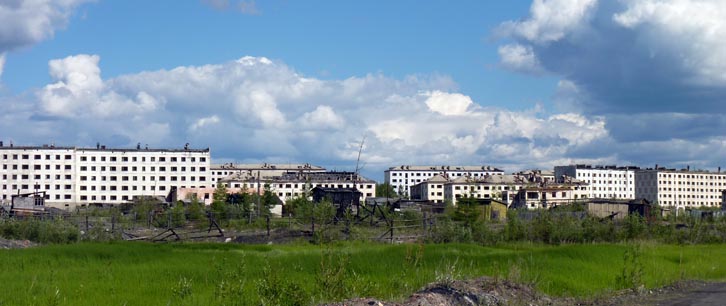
Kadykchan was founded in 1960 to house coal miners. At its peak, it had some 12,000 inhabitants. To attract residents (there was some degree of choice in the USSR), it offered large apartments and good facilities. Even though available land and space were unlimited, central planning dictated that the same style apartment blocks be built across the empire, from the scorching deserts of Turkmenistan to the frozen taiga of Siberia. The new Soviet man would in a concrete high rise, normally five or six stories tall (but without elevators).
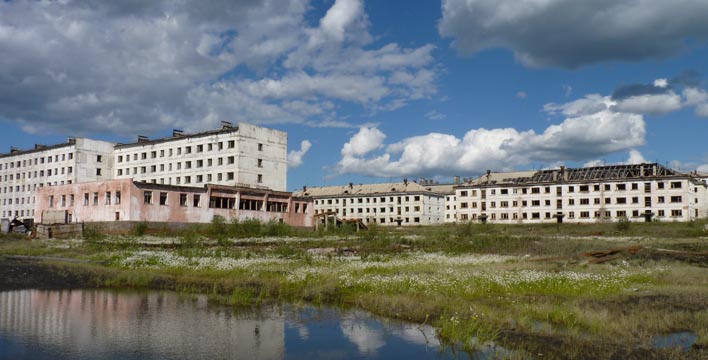
Here is a description I found:
Conditions in the town were rough. Completely isolated from both Western and Eastern Russia, Kadykchan was a very remote settlement. Work shifts lasted twelve hours, seven days a week – and there were no holidays. Winters lasted ten months and there was little to do in the town with nothing to do outside it. The nearest city center is several days’ drive away, and for much of the year weather conditions make the highway impassible.
Unlike Pripyat, Kadykchan was abandoned gradually. The city was already in decline when an explosion in 1996 led the the closure of the mines. With less and less reason for continued existence and as subsidies were withdrawn, people began to move away at an accelerating pace. Judging from the detritus, it looks like the final gasp came in 2002. I find a newspaper dated October 17, 2003, but it could have been left by squatters.


Surprisingly, the housing blocks abandoned earlier are in relatively better condition. The last holdouts appear to have been squatters who pulled up and burned the hardwood floors for heat and left behind thousands of empty beer and vodka bottles. All fixtures and copper wire have been scavenged/looted. Lots of books and obsolete appliances were left behind. Most poignent are the scattered childrens toys, but it's not like their owners disappeared; more likely they grew up and moved away.
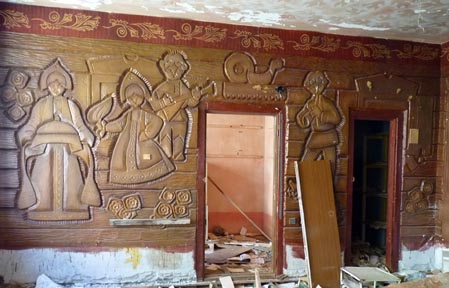
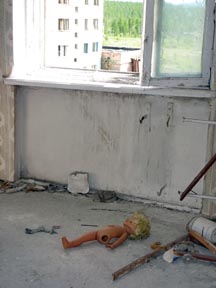
A medical clinic is full of ampules and preparations (I assume that anything “good” was long since looted.) The best treasure trove of all is the school: textbooks and teaching aids galore. Phonograph records cover the floors. I pick a souvenir: a geography book of the USSR from 1991 (final edition!) emphasizing economic development and achievements.

City Hall yields another find: a notary sign (Нотриус, pronounced “notorious”) which I take as a souvenir. Others pick up party membership credentials and other official documents that, in the end, proved to be not so important.

After two hours of exploration we meet to have lunch and compare notes. Then, we finish out the afternoon with more of the same. There is no way to see everything. I don't have time to get the to industrial-looking area, and we are warned away from other parts due to reports of resident bears.
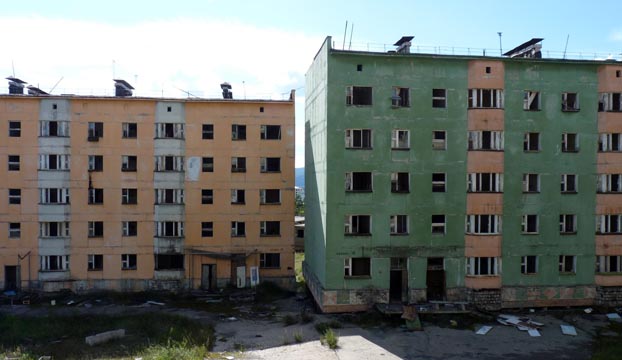
After a day of modern archeology, it’s back to Susuman for the night and then the long ride back to Magadan.
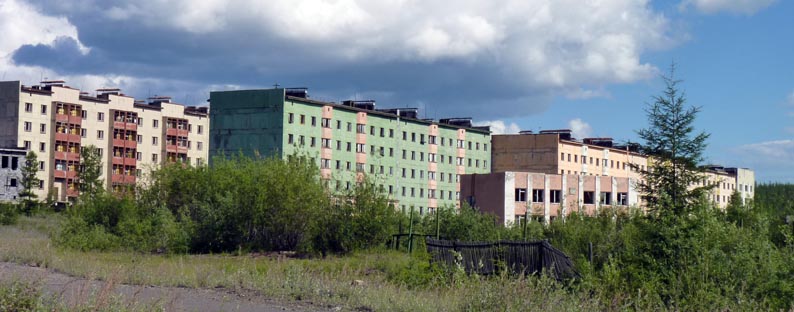
The final morning is devoted to last-minute souvenir shopping. I blow the budget on walrus penis bones and mammoth teeth. Then, our last meal as a group, served at the nearby apartment of a guide's mother. It's a sumptuous feast featuring many varieties of fresh seafood, by far the best of the trip. The family is Volga German, who emigrated at the invitation of the tsars in the 18th century and deported en masse by Stalin in 1941. Our host family was shipped first to Uzbekistan and eventually migrated to the far east. I depart the meal early to be taken to the airport.
My flight to Moscow is like a time warp: I get on the plane at 3 PM, take off, fly for eight hours, and step off at 3 PM the same day. If I could keep it up, I would be immortal.
There's no need to change airports for my flight to Minsk. There's no passport control either. Flying time is just over an hour. The terminal at Minsk 2, the international airport, looks like a cross between Brezhnev futurism and something from The Jetsons. The only planes at the airport are those of the national airline, Belavia.
I am met and taken to the city by the service from which I have rented an apartment. (Minsk hotel rooms are terribly overpriced.) It is in an historic building, one of the very few that survived the war, smack in the center, across the street from the five-star hotel. The entrance and stairway are grim, crumbling concrete (like those in Kadykchan), but the apartment interior has been completely redone and fitted with the latest German fixtures and appliances. It has one large room, a kitchen and a bathroom – perhaps a bit cramped for a soviet family but just right for me.
Minsk was largely flattened when the Red Army retook it in 1944. A few major buildings were restored, but pretty much the entire city is post-war: wide, straight boulevards, heroic-scale monuments, and stolid concrete. The rebuilt city has a Stalin-era core surrounded by grim Khrushchev-era housing blocks, then a ring of Brezhnev-era high-rises. On the outskirts single-family housing of more recent vintage: proof that when people have a choice their preferences diverge from those of the planners. This pattern is repeated in the other cities I visit.
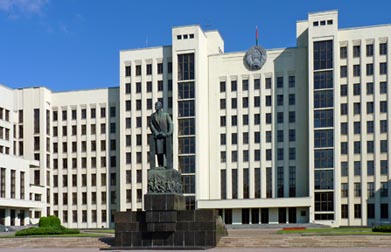
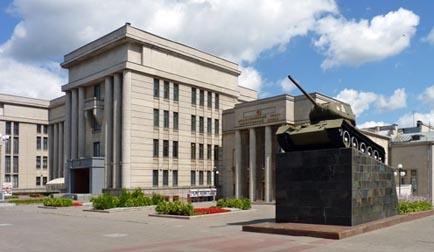
Belarus, f/k/a Bylorussia or “White Russia,” is ethnically and dialectically distinct from Russia. It first appeared as a political entity as one of the republics of the Soviet Union and even had its own seat at the UN (as did Ukraine). When the Soviet Union collapsed in 1991, it became independent but never changed its system. Politically and economically, this is a remnant of the USSR; to visit here is to see the soviet system plus twenty years of natural evolution. Russia's economy is now 85% private and 15% state-run; here that ratio is reversed. The streets are still named after Lenin and Marx, and the KGB is still the KGB (in Russia it’s now the FSB).
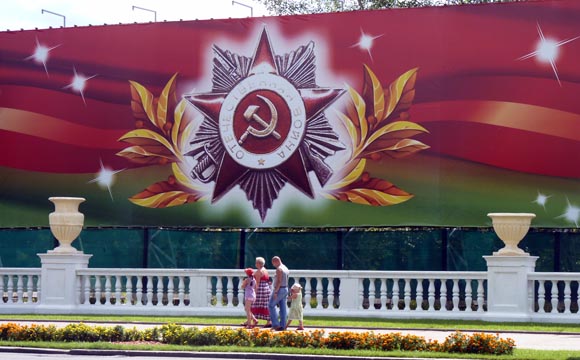
I arrive Saturday night. Sunday morning I begin my walking tour. In the historic center bells are pealing in the restored and reopened churches. Down to Lenin Square where a very large statue of ole Vlad still holds pride of place. Up the main boulevard, past imposing government buildings, past the block-long KGB headquarters and bust of Felix Dzerzhinsky, local boy made good and head of the Bolshevik secret police (his statue was the first to be removed in Moscow), past the GUM department store in Stalin rococo, past October Square and the Palace of the Republic and the Trade Unions Palace of Culture, past the State Circus, a slight detour to Lee Harvey Oswald's former apartment at 4 Communist St, then to Victory Square and its imposing obelisk.
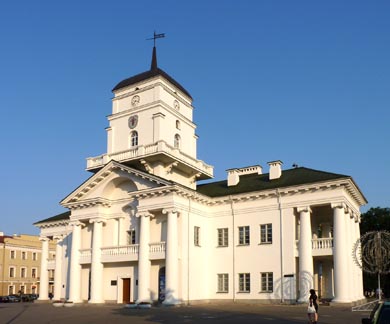

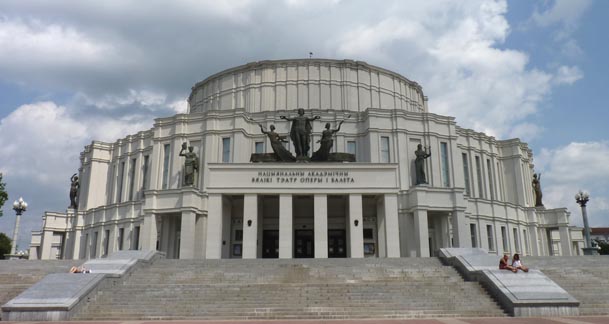
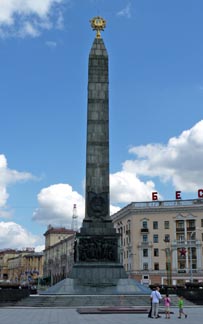
I take in the Museum of the Great Patriotic War (WWII), the first of its kind in the Soviet Union but, to my disappointment, far from the best. I hike down to the reconstructed old quarter alongside the river. Facing it is the Isle of Tears on which is the memorial to the dead from the ten-year misadventure in Afghanistan. There's nothing triumphal or monumental about it; like our Vietnam War Memorial, it's inscribed with the names of the dead (700) and is all about sorrow. Interestingly, it's identified as the “Memorial to Fallen International Warriors”; these soldiers who went abroad to provide fraternal socialist assistance are not to be confused with the sort of fascist foreign invaders that occupied the Belarussian homeland forty years prior.
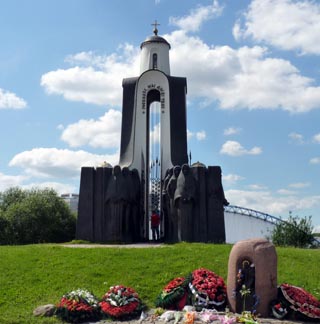
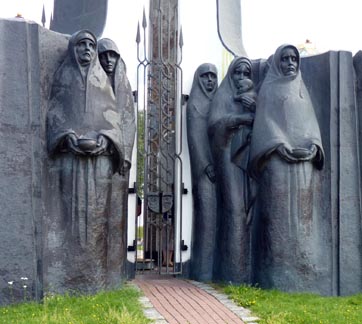
That pretty much polishes off the day. The next day, Monday, everything touristic is closed so I declare a day of rest. I do visit my sponsoring tour company, Prime Tour, to pick up my train tickets. My druthers are to come up with an itinerary on the fly, traveling when and where the mood strikes, but that's not the deal here: each night must be accounted for in advance. While independent travel is permitted, to get a tourist visa you need to have your itinerary planned and paid for.
On Tuesday I make my way by public bus to the folk life village of Dududtki, a part of every Minsk tourist itinerary. I am underwhelmed. It has the last surviving windmill in the country, a newly constructed wooden church, and a handful of craft and rural life demonstrations. Methinks its significance stems from so little having survived Stalin's forced collectivization in the 1930s and scorched-earth retreat policy in response to the Nazi invasion in 1941. I take my cue to leave when a busload of Taiwanese tourists stages a modern invasion.

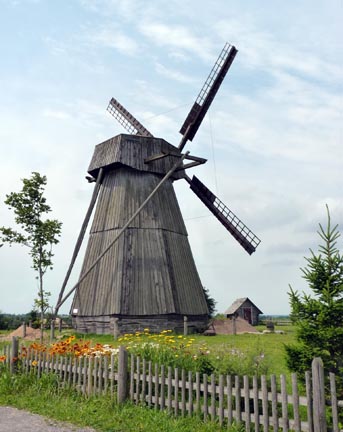
A word about prices here: they are astonishingly low. Two months earlier the Belarussian ruble collapsed, declining to 5000 to the dollar (previous level 3000), and prices have not yet risen to match. Bus or metro fare, 15¢; loaf of bread, 40¢, ice cream, 45¢; big bottle of water, 50¢; it's hard to spend a dollar. If you don't want to pay 50¢ for a bottle of Coke, Bela-Cola, offered by the Minsk Alcoholfree Drinks Factory Company, is a budget alternative. But it's not like things here are free: the information booth at the train station costs 1¢ (actually, questions are free; answers cost a penny).
Besides low prices, other advantages of Leninism are an absence of street crime, petty corruption, grafitti, and litter. Pedestrians dutifully wait at crosswalks for the green signal even though there is not a car in sight. (Figuring that deportation or imprisonment is unlikely, I jaywalk at will.)
I witness the downside from my apartment window: passing by on the street below is the regular Wednesday-evening “clapping protest.” Since every sort of political expression in opposition to the government is banned, dissidents have taken to simply clapping their hands. A few brave souls walk through the streets “applauding the regime”; they are followed by a much large group of silent supporters, people videoing, and thuggish-looking plainclothesmen. To combat this menace to law and order, the rules have just been tightened to prohibit groups of people just standing around.
Part of every Minsk tour is the memorial at Khatyn. Erected on the site of a small village wiped out by the Germans in a reprisal raid in 1943, it commemorates the 618 villages that met a similar fate, of which 185 were never rebuilt and disappeared entirely. A frequent tactic of the occupying Germans in reprisal for partisan attacks was to round up the inhabitants of a target village, lock them in a barn, and set it on fire. At Khatyn there was one survivor; at the entrance to the memorial is an oversized statue of him holding his dead son. There are chimneys where each of the 26 houses stood; in each is a bell that chimes every thirty seconds. There are symbolic graves for the vanished villages, and memorials to the various concentration camps on Belarussian soil. It's a somber place; the guide said that Moscow was not pleased with the design because there is nothing about heroism, resistance, and revenge. Belarus took it harder than most any other country in the war – a quarter its population perished.
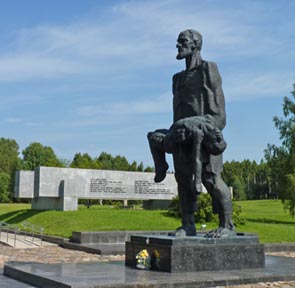
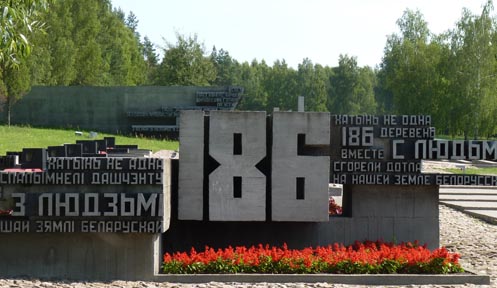
I have to pay for a private tour to get to Khatyn because there is no public transport. This is unusual in a socialist country where ordinary people don't have cars. I ask the guide why, and she replies that everyone has visited the site so many times as part of school groups that they are Khatyned-out (my words, not hers).
The reason that a major memorial is at site of a relatively minor atrocity is simple: in the English/Roman alphabet (but not in Russian/Cyrillic) “Khatyn” looks and sounds like “Katyn”. The Soviets selected it to deliberately confuse and distract Western visitors from the entirely distinct massacre in the Katyn forest (in Russia) where Stalin had the entire 20,000 member Polish officer corps shot and later tried to pin the blame on the Nazis.
In the afternoon I visit a farmers’ market. Belarus has excellent agricultural conditions, something you would never know from the pitiful produce displays in the supermarkets. Just like in Soviet days, the farmland is owned by the state and worked in collective farms but individuals are permitted to cultivate private plots. The resulting distinction is like night and day. What is on offer in the farmers’ market would stack up against any Western greenmarket and at jaw-droppingly low prices.
The next morning I leave my apartment for the last time and set out on my ‘round ‘rus tour. I skinny down to a gym bag, store my big bag at the train station, and catch a bus to Mir.
Mir castle belonged to the Radziwells. It was left in ruins after the Napoleonic Wars and only recently restored. On a nice day, which this is, it makes a nice photo. It is of particular significance because unlike, say France or Germany, there are not a lot of castles in these parts.
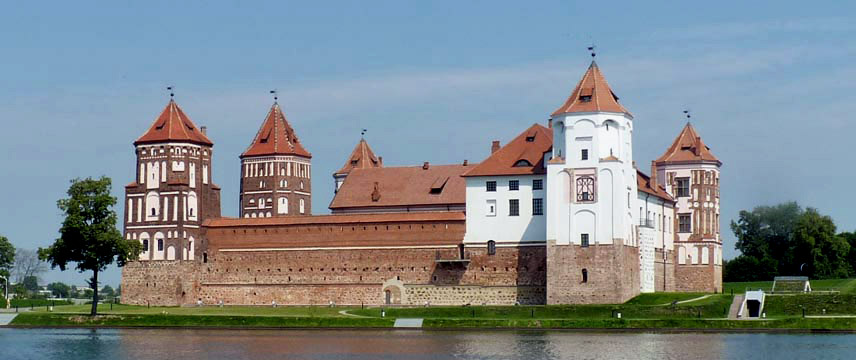
Mir is normally visited as a day trip from Minsk, but I intend to keep moving. Outside of Minsk the number of people who can speak English dwindles to near zero, but enough people know German to enable me to get around. My destination is Grodno. Due to circuitous bus routes it takes me the rest of the day to get there.
The Hotel Belarus is a soviet pile on a hilltop a mile or so from the city center. I trudge across the huge and empty lobby to the registration desk in the far corner where the woman glances at a handwritten sheet and asks “Prime Tour?” She writes me out a key card (proof of residence) for me to show to the key lady on my floor. This is another unreformed soviet practice: the room keys are kept by a functionary on each floor who can also keep track of the comings and goings of guests and their visitors. In the room, each item of furniture is prominently marked with an inventory number.
It's late, and I'm hungry. The doors from the hotel lobby to the restaurant are locked, so I have to go outside and walk around the building to the street entrance. Inside, there are at least 75 tables, all fully set and all empty. In one corner the staff is kibbutzing. I take a seat. After twenty minutes one brings me a menu. Of course, it's all in Russian so I have to guess and point. They bring me a bowl of borscht/cabbage/vegetable/baloney soup and some black bread, which hits the spot. The price is right, less than $2, and at least the lousy service doesn't come with the expectation of a tip.
Grodno was a Polish city until Stalin readjusted the border and resettled most of the population elsewhere. It made it through the war in pretty good condition – the German army rolled through it on the first day and there was not much fighting when the Red Army returned three years later – so its architecture is an attraction. There is an old castle, a new castle, and a number of churches. I have the full day to explore.
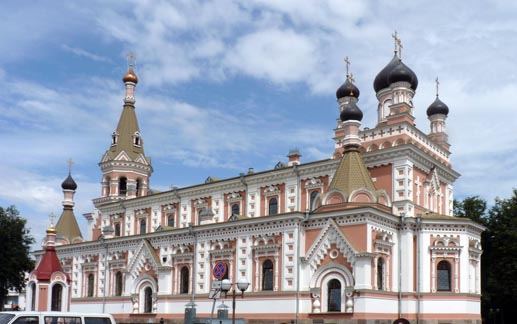
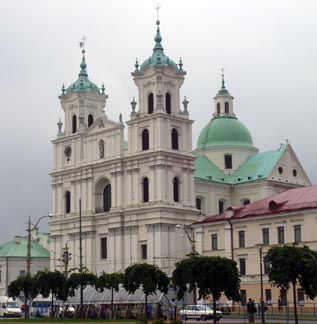
Checking out of the hotel I ask them to store my bag for the day. “Nyet!” So I take it to the train station where the luggage room will look after it for a charge of 20¢. The station is hideous almost beyond description; huge, concrete, with glass and plastic highlights, it is the ugliest building I have seen since the Tito-era monstrosities in Yugoslavia.
Brest is less than 150 miles south of Grodno, but getting there by train takes almost thirteen hours. The problem is that the rail lines run east and west so our car gets shuttled back and forth like a sailboat tacking in the wind. But I enjoy sleeper trains and the overnight journey saves the cost of a hotel room. I ask my compartment mates why didn’t opt for a four-hour bus ride: it's cheaper; for them the train ticket cost less than six dollars (I think I had to pay 28). But there are hidden charges: a set of clean bed linen costs an additional 70¢.
We arrive in the morning at Brest. Knowing that my hotel is some distance away, I hop on a streetcar heading in more or less the right direction. After a few stops and turns the street signs bear no relation to the guidebook map, so I get off at the next stop. The hotel is right in front of me. My homing pigeon instinct comes through again.


The Intourist Hotel (not to be confused with the Belarus Hotel also in Brest or the Intourist Hotel in Grodno) is another grey concrete high-rise. Intourist was the state-run travel monopoly in the USSR; there are now private tour companies in Belarus but Intourist still owns and operates the hotels. The attitude of the employees remains unchanged, i.e., that their jobs would be more pleasant if people didn't keep disturbing them by showing up and wanting to check into the rooms. This time I encounter something new: a demand for proof of medical insurance. I have a card identifying my travel insurance policy good worldwide, but it not issued by the Belarus health ministry and isn't written in Russian. Probably because they realize that I am going to stand there and not go away and leave them alone, they relent and give me my room.
The room has the fit and finish one would expect from soviet craftsmanship. The footboard on the bed prevents a person of normal height from stretching out. In the height of summer the heat is on and the windows wide open.
Situated on the Bug River (which is the name I thought should be given to ALL the rivers in Magadan) and the Polish border, Brest has historically been the western edge of the Russian empire. In the mid-nineteenth century a huge fort was constructed here, where, in the 1918 treaty of Brest-Litovsk (as the city was then known), Lenin threw in the towel on WWI. In 1939 Stalin reacquired the city, which set the stage for the events of 1941. The fort held out against the Germans for six weeks even though the front by then had moved hundreds of miles to the east. This act of resistance was a singular exception in a season of military disaster. The fort was designated a “hero-fort” and Brest a hero-city” of The Great Patriotic War.
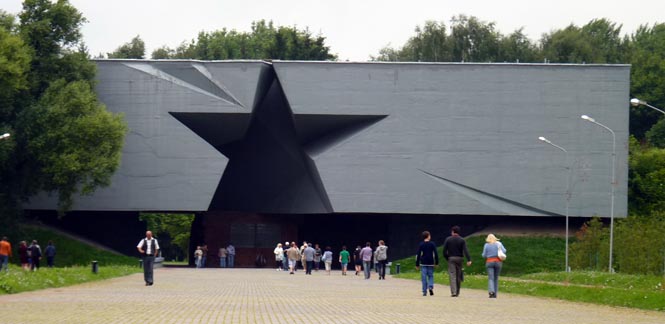
Just about all the defenders died. The fort is a monument to their sacrifice. Huge sculptures dominate the landscape. Patriotic music plays constantly. Inside, a museum, usual theme. Keeping alive the memory is job #1 even as the day fast approaches when the last veterans are gone.

Nearby is a railroad museum of historic locomotives . Also, a Museum of Confiscated Art. This being a major border crossing between the EU and the CIS (successor to the USSR), over the years hundreds of objects d'art have been seized from smugglers trying to get art treasures out to sell in the west; these items have been placed in a museum. On display is an eclectic variety of paintings, antiquities of every sort, and even rooms full of furniture. There are hundreds of religious icons, but I note that no one was trying to smuggle out portraits of Lenin or any other soviet icons.
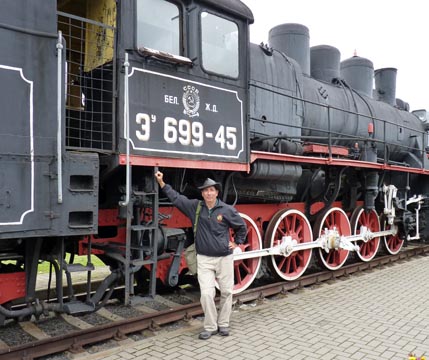
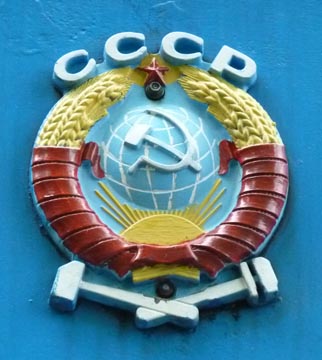
Pinsk is usually a day trip from Minsk or Brest for visitors who have transport, but since I don't I make it an overnighter. It is one of the oldest towns in the region, over 1000 years. It was of great importance in various medieval periods but has faded in modern times. Proof of its tertiary importance is that in the center of the city is Lenin Square, but it doesn’t even have a Lenin statue. By the eve of WWII the city was 90% Jewish, but almost no trace remains. The current city is an interesting mix of wooden houses, classical buildings, and soviet constructs all jumbled together. There are a couple of nice churches, including a Russian Orthodox rebuild – the Soviets razed it and erected a cinema that was in turn torn down and replaced with a copy of the original church.
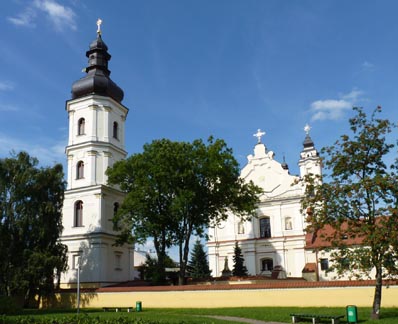
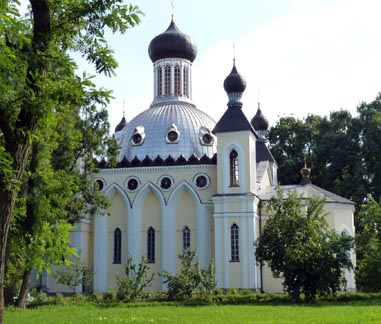
I make my way to the river and my hotel, another high-rise of crumbling concrete. In the empty lobby a lone women sits on a couch watching TV – she acts terribly put upon to get up and register me, which consists of grabbing my passport and handing me a key. Even though the hotel has a couple of hundred rooms, I see no signs of any other guests. (Correction: there is someone else; I see him at breakfast.)
Pinsk is a pretty quiet place on a Sunday afternoon. A few people stroll along the riverbank. There's not a lot to do or see, but it's a pleasant place. In the evening I take the opportunity to write this trip report.

Normally, I would visit another city before making my way back to Moscow, but that's not how things work here. I need to return to Brest Monday night. Ironically, I board the Moscow-to-Brest train; in another hour its counterpart stops at Pinsk station on the way from Brest to Moscow.
Back at the Intourist Hotel (still empty), this time I am given a renovated room: it is decorated in modern poor taste rather than the 1975 version, and in this rendition everything more or less fits together, at least mechanically if not in taste.
Mid-morning on Tuesday I take the train to Minsk and reclaim my big bag. To redeem it from five days storage costs just over a dollar. In the evening I board the train to Moscow.
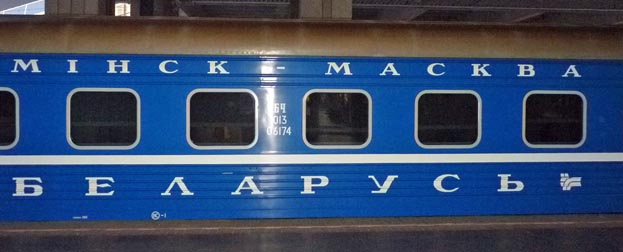
Train #001/002, the premier service of the fleet, offers fancy, new, plush rail cars. It’s also pricey – as much as an air ticket – but, due to scheduling and wrong airport, flying is not an option. There is no passport check, so my sleep is undisturbed. In the morning we arrive on schedule in Moscow’s Belarussky Station, which also happens to be the departure point for the airport express. I check-in in plenty of time to enjoy the amenities of the Aeroflot lounge (also used by Delta). A long but comfortable non-stop flight to Atlanta gets me to the steamy heat of Jacksonville in July. With Belarus, that’s 14 of the 15 republics of the former Soviet Union I’ve visited so far. Tajikistan, you’re next!
Trip date: July, 2011
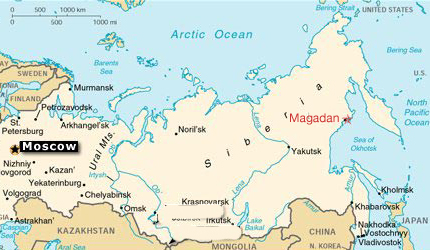
 >
>

 >
>
